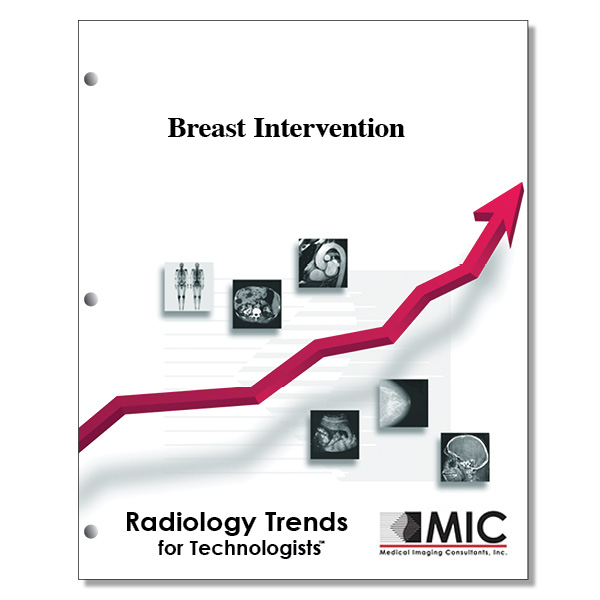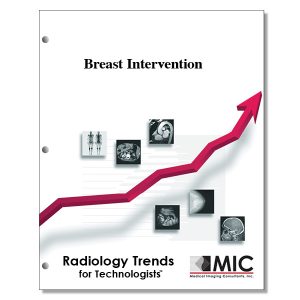

Breast Intervention
After identifying suspicious findings with mammography or breast MRI, this review focuses on biopsy techniques and other breast interventions.
Course ID: Q00409 Category: Radiology Trends for Technologists Modalities: Mammography, MRI, Nuclear Medicine4.25 |
Satisfaction Guarantee |
$39.00
- Targeted CE
- Outline
- Objectives
Targeted CE per ARRT’s Discipline, Category, and Subcategory classification for enrollments starting after May 25, 2023:
[Note: Discipline-specific Targeted CE credits may be less than the total Category A credits approved for this course.]
Breast Sonography: 4.25
Patient Care: 1.50
Patient Interactions and Management: 1.50
Procedures: 2.75
Breast Interventions: 2.75
Mammography: 4.25
Procedures: 4.25
Mammographic Positioning, Special Needs, and Imaging Procedures: 4.25
Magnetic Resonance Imaging: 4.25
Patient Care: 1.50
Patient Interactions and Management: 1.50
Procedures: 2.75
Body: 2.75
Nuclear Medicine Technology: 3.00
Patient Care: 1.50
Patient Interactions and Management: 1.50
Procedures: 1.50
Endocrine and Oncology Procedures: 1.50
Registered Radiologist Assistant: 4.25
Procedures: 4.25
Thoracic Section: 4.25
Sonography: 4.25
Patient Care: 1.50
Patient Interactions and Management: 1.50
Procedures: 2.75
Superficial Structures and Other Sonographic Procedures: 2.75
Radiation Therapy: 2.75
Patient Care: 2.75
Patient and Medical Record Management: 2.75
Outline
- Introduction
- Validation of Percutaneous Image-guided Biopsy
- Current Procedures
- Preprocedural Considerations
- Stereotactic Biopsy
- Indications
- Equipment
- Technique
- Potential Challenges
- US-guided Biopsy
- Indications
- Equipment
- Technique
- MR-guided Biopsy
- Indications
- Equipment
- Technique
- Postprocedure Considerations
- Summary
Objectives
Upon completion of this course, students will:
- list the advantages of image-guided breast biopsy over surgical biopsy
- define success for core needle biopsy programs
- understand the type of biopsy using a thin hollow needle for removing cell samples
- specify the percent of image-guided percutaneous breast biopsies performed in the U.S. annually
- state the percentage of benign breast biopsies performed in the U.S.annually
- explain how palpable lesions not seen on imaging are biopsied
- list the components of a long-throw, spring-loaded biopsy needle
- distinguish between tissue troughs for long and short-throw needle systems
- explain requirements when discordance between imaging and pathology occurs
- differentiate between concordance and discordance with regard to imaging and pathology findings
- compare and contrast BI-RADS codes
- know the risks involved in an image-guided breast biopsy
- understand discontinuation of aspirin and Coumadin pre-biopsy
- distinguish between multi-focal and multi-centric
- recognize the most frequently used imaging modalities for image-guided breast biopsy
- categorize equipment used for image-guided breast biopsy
- explain ways to increase patient understanding and cooperation during breast biopsy
- recognize routine information required on written informed consent
- define “timeout”
- list potential complications associated with ultrasound-guided breast biopsy
- list contraindications for image-guided breast biopsy
- differentiate between sensitivity and specificity
- indicate appropriateness for stereotactic biopsy technique
- describe table systems for stereotactic breast biopsy
- state the advantages of using a dedicated prone biopsy table
- list patient positioning options when using an upright biopsy unit
- identify factors needed to determine biopsy needle approach in stereotactic technique
- describe how accurate needle placement is confirmed in stereotactic breast biopsy
- explain how to minimize the accordion effect
- list challenges to stereotactic breast biopsy
- explain equipment adaptations that help alleviate negative stroke margin
- identify advantages of ultrasound-guided breast biopsy
- know the transducer strength needed for highest quality US guided breast biopsy
- describe advantages to hand-held VAD for ultrasound breast biopsy
- describe ultrasound biopsy patient positioning for solid lesions
- explain US guided breast biopsy patient positioning for medially located lesions
- state the best method to visualize needle route during US guided breast biopsy
- explain advantages of dermatotomy
- verbalize the number of core samples taken during US guided breast biopsy
- explain marker migration in US guided breast biopsy
- determine indicating factors for MR-guided breast biopsy
- note the magnet strength required for MR-guided breast biopsy procedures
- list imaging professionals who are part of the MR-guided breast biopsy team
- describe patient positioning for MR-guided breast biopsy
- state how benign concordant lesions are followed after MR-guided biopsy
